

Art History
People have made and contemplated visual art
for over forty thousand years. Australians
buried forty-two thousand years ago
show traces of coloured ochre decoration.

For about 80,000 years, people have migrated
over the Earth's continents. As the globe was
settled, people traded materials and ideas
(including art) between different communities.

Above: Metal thread bag. Syria,
Turkey, Iraq, Iran
and Afghanistan traded copper, gold,
jewellery and
textiles along vast trade routes 4,000 years ago.
With the development of modern science, especially
optics in Islamic countries, artists explored the use
of objective perspective. Perspective spread to European
Renaissance artists such as Leonardo Da Vinci in the 1400s.
By the 1600s, Dutch painters such as Jan Vermeer were
using large pinhole cameras to project images in their studios.
Pinhole cameras helped artists paint perspective accurately.

Perspective in a traditional oil landscape. (Bereneice Tate 1912).
From about 1500, Portuguese and other Europeans strongly
traded by sea with Asia. Trade also led to exchanges in
knowledge and artworks between 'Eastern' and 'Western'
communities. By 1800, full colour woodblock prints were
often published in Japan and shipped to picture collectors
in Holland.

Full colour Japanese woodblock print of
a koto celebrity. (Kitagawa Utamaro 1800.)
This exchange of visual ideas and images between world
cultures drives Modern Art. Collectors of Modern Art support
artists in the international exploration of visual culture.
For example, a French originator of 1800s Impressionism,
Claude Monet, filled his house with Japanese prints
including Utamaro's prints. Monet built a large Japanese
lake garden and Japanese bridge on his estate at Giverny
outside Paris. Then Monet painted his Eastern creation.

Above: 100 years after Monet, Brett Whiteley continued
modern art's east-west north-south synthesis (Aaqus 2018).
Besides the exploration and synthesis of Eastern and Western
culture in Modern Art, a second driver of Modern Art is the
development of chemical photography by Fox Talbot (1835)
and L.J.M. Daguerre (1839).

Daylight still life photograph after Talbot (Aaqus).
The invention of monochrome photography created a new branch of
visual art. After the 1830s, people who wanted an objective image
could take a photograph. Painters worked with photographers to
paint objective colours into the photographs for one hundred years,
until commercial colour photography was developed in the 1940s.
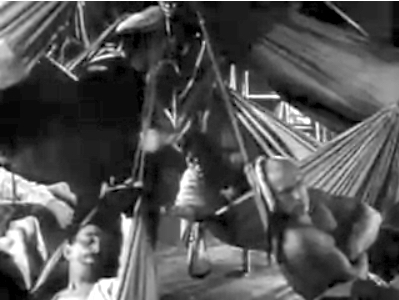
Above: Soviet film theorist and movie director
Sergei Eisensein's Battleship Potemkin (1925).
Artists first created motion cameras to film people in 1888.
The first movie feature (Melbourne 1906) heralded a worldwide
silent economy (plus music) with no spoken language barriers.
After the 1830s invention of black and white objective photographs,
painters were free to explore many other aspects of fine art
painting that were untouched by photography.
Modern painters emphasise the realistic situation that faces
any person who looks at landscape or people.
The reality of looking
always consists of the objective view of the scene
and each person's subjective feelings, desires and
beliefs about what they personally choose to see.
'Reality' that combines shared objective views and personal subjective
interpretations is the third driver of Modern Art. A collector of
Modern Art buys into a realistic process that emphasises both the
artist's experience and the artist's object of exploration.
From the 1850s, French artists looked to Japanese prints and Eastern
artworks for inspiration. A print's graphic treatment of colour, texture,
genre and landscape scenes inspired similar explorations of colour,
texture, genre and landscape scenes in Modern European painting,
such as Impressionist painting in the landscape.

Watercolour near the artist's birthplace
by E.N. Watson-Wastie 1959.
Impressionist painting explores the painter's real-time experience
in society and the landscape. Light is always changing,
shapes are moving, some colours or textures hold the artist's attention,
and others blur into uncertain highlights and shadows.
The free exploration of colour and shape led to Fauvist paintings,
such as works by Henri Matisse.
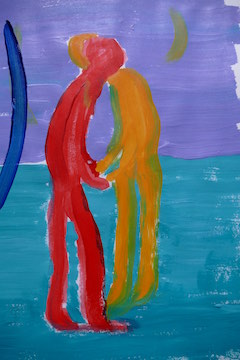
'Fauve Friends' after early 1900s
Matisse. (Aaqus).
The free exploration of gesture, line, brushstroke and texture
leads to Expressionism.
The Aaqus expressionist painting below captures in brush strokes
the experience of dancing with a stage star in a Sydney night club.

Expressionist painting: 'Dancer' by Aaqus.
Not only is the life, passion and movement of the actress dancing
in a Sydney nightclub observed, but the viewer also experiences
the life, passion and movement of the artist's colour and brushstrokes
on dark 'nightclub' textile.
Besides Utamaro, another strong print influence on Modern Art comes
from Katsushika Hokusai. Hokusai's print (below) shows a page of cubist
or constructionist explorations in the artist's sketchbooks. Hokusai's
sketchbooks were published for art collectors 60 years before the
Europeans expanded similar explorations into Cubism and Constructivism.
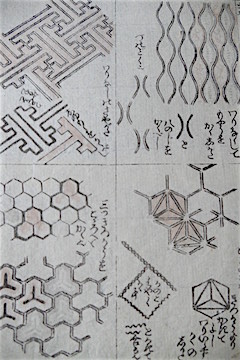
Sketchbook explorations of the cube
and other structures, early 1800s. (Hokusai).
Modern Art considers people's thought and action among others in scenes
and landscapes. Modern Art's focus on both shared outer objects and on
inner subjective experience leads many artists to explore consciousness,
the unconscious, dreams and existential alienation. Modern Art takes up
inner exploration in painting styles and processes such as Surrealism.

Surrealist painting: Dreamscape from the Dream Diary. (B. Watson 1980s.)
Expressionist painters such as Jackson Pollock and Mark Rothko expressed
their exploration of surreal, dream, unconscious or spiritual experiences
and processes in 'New York School' styles of Abstract Expressionism.
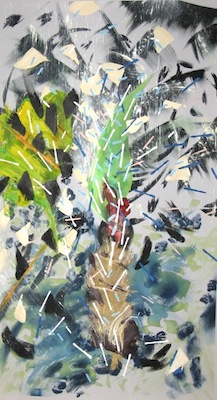


The artist Aaqus's style emerges from all these Modern Art strands, especially the dual
Eastern and Western underpinnings of world Modern Art, including the New York School
Abstract Expressionism of Jackson Pollock.
The viewer sees wild nature such as a young palm in a Queensland storm.
What distinguishes Aaqus from Pollock (and say, Utamaro) is Aaqus's
concern to keep our Earth's essential and disappearing wild landscape
firmly balanced in the subjective abstract expression.
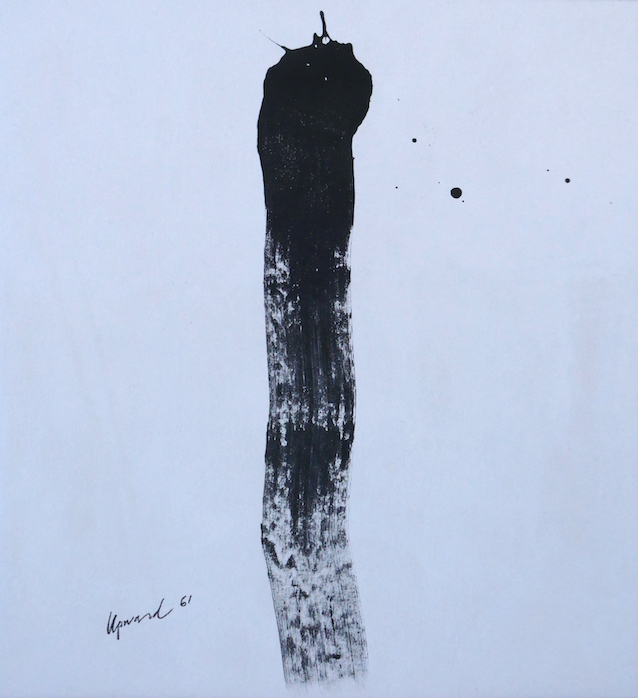
A Zen brushstroke. Aaqus after Upward
Along with nature, the Aaqus Modern Art painting is a zen meditation -
thoughts released - from the artist's mind.

Javanese batik techniques.
Besides brushstrokes, Aaqus's unique Modern Art style expresses most meditations with
Javanese batik techniques such as the batik patterned 'city' treatment in 'Kunanyi' 2018 below.
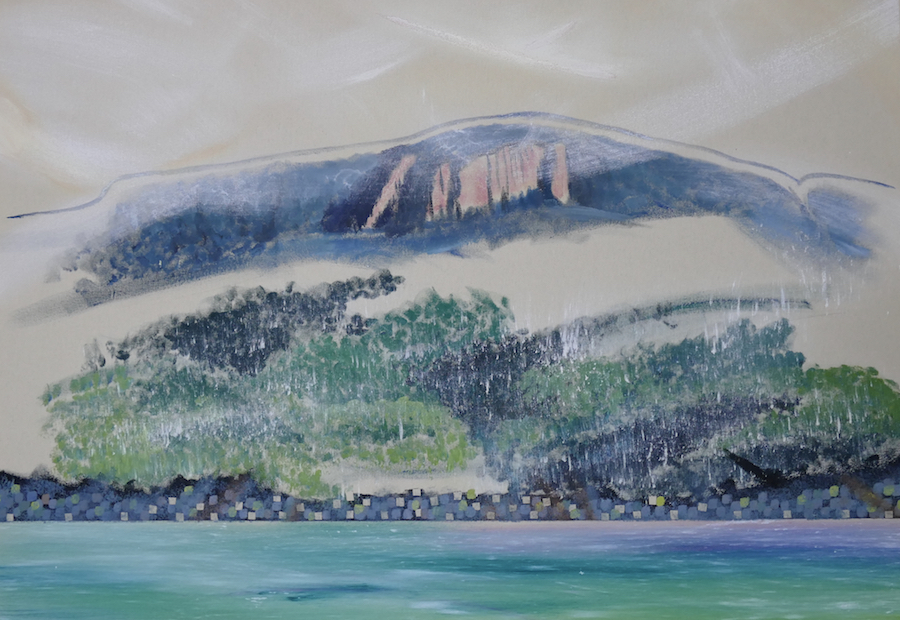
Zen batik and brushstroke expressions in Kunanyi (Mt. Wellington). Aaqus 2018.
Two entwined strands of everyday reality - objective landscape and
subjective brush strokes - drive an Aaqus original.
Along with inspiration from Eastern Art, 1900s artists such as Pablo
Picasso also explore the aesthetics of African art, such as tribal face
masks. Again Modern Art explores and remakes traditional visual
cultures as a diverse modern world visual culture.

Traditional African Mask montage (Aaqus).

After African masks in Picasso's
Demoiselles d'Avignon 1907. (Aaqus).
Modern Art concepts flow back and forth between artistic communities
the world over. Matisse's Fauvist expression in Fauve Friends (earlier)
has returned to Africa in the sculpture of West Kenya. Modern Art is
international in essence.

Contemporary African Modern Art
sculpture of Two Friends, Kenya.
Compare with 'Fauve Friends' after
Matisse.
Two other cultural regions that have survived colonisation are Indonesia
and Aboriginal Australia.In both places, traditional artists have emerged
with fresh inspiration that explores the ideas and technologies of
Modern Art. Artists such as Agris and Nelson use their hybrid Modern Art
talents to explore both traditional culture and today's landscape, ideas and
society around us.
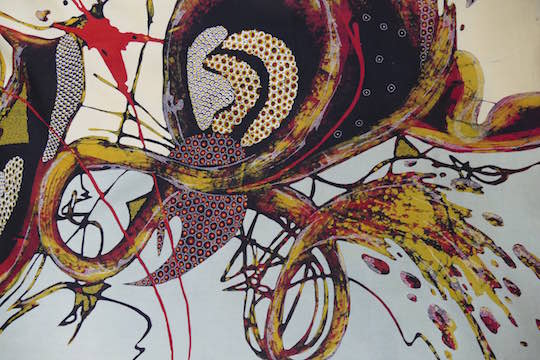
Javanese abstract expressionist seascape 'Wave Hitting Two Rocks'.
Modern Art Batik by Agris, 1986.

Australian Aboriginal Dreamtime
painting 'Janganpa Jukurrpa'
by Steven Jukurrpa Nelson 2017.
Modern Art - A Summary.
Modern Art inovation emerges from cross-pollenation of many cultures.
Many cultures join the ongoing hybridisation of Eastern, Western
and world art which is Modern Art.
Now that photography strongly handles 'objective' visual culture,
Modern Art painting frees the artist and the viewer to better explore
our lived realities of personal experience amongst the defended
landscape and our dynamic world community.
Modern Art achieves this exploration via colour, pattern, brushstroke,
other visual abstractions, the textile or background material, expressive
marks and pictographs.